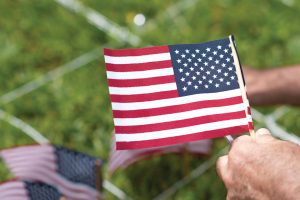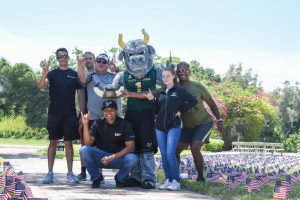Bias by design
A psychology researcher seeks to tease out how pre-trial publicity impacts jurors
Christine Ruva, PhD, saw a lot of high-profile criminal cases when she worked as a probation and parole officer in Pinellas County in the 1990s, and she always wondered what effect media coverage of those cases had on juries’ decisions.
Over the past few years, Ruva, now associate professor and chair of the psychology department at USF Sarasota-Manatee, has developed complex simulation experiments to try to answer her long-held questions about jury bias.
“At trial you have two different sources of information – all the stuff that came before trial – the pre-trial publicity, or PTP – and then you have the actual trial information,” Ruva said. “My question was, can jurors differentiate between the two?”
To determine the impact of PTP on jurors, Ruva and her team of mostly USF Sarasota-Manatee campus undergraduates spent nearly two years developing a scenario they could use to test jury bias.
"Once jurors have been exposed to [pre-trial publicity] they can’t unhear it. They come to court with a story and they’re going to try to fill it in with evidence."
They took key moments from an actual trial about a woman accused of murdering her husband – she claimed the killing was self defense – and edited it down to a 25-minute video. They also developed three types of pre-trial publicity – anti-defendant, anti-victim and neutral.
“We recruited 648 USF students to come into the lab, read actual news stories about the crime, then come back a week later and view a video of the trial,” Ruva said. “They provided individual verdicts, then they got into juries and deliberated, and after they reached a verdict we asked them to provide individual verdicts again.”
The result: “My suspicions were confirmed. They had a very difficult time discriminating between information presented at trial versus that which came prior to trial. They had strong confidence that pre-trial publicity was, in fact, presented at trial.”
Once a jury is chosen, the judge typically tells the jurors not to read or watch anything about the case, but Ruva said, “by then it’s too late. They’ve already been tainted.
“Once jurors have been exposed to this information they can’t unhear it. They come to court with a story and they’re going to try to fill it in with evidence that fits the framework they have already developed.”
Ruva said jurors don’t have to remember all of the details about a crime that they saw on television or read in a newspaper or on Facebook.
“It’s not that they need to remember all the details,” she said, “they just have to be biased by it, tainted by it, have a view of the defendant that he probably did something, that he’s not a good person, that he’s actually a scary person.”
Ruva said the legal system believes different jurors’ biases will cancel out during deliberation – “the tainted will become untainted” – but by carefully correlating the
jurors’ verdicts before and after deliberation, she has been able to show the opposite is happening.
“One of the most interesting things from this study is that the untainted jurors, the ones who had read the irrelevant pre-trial publicity but who deliberated with the jurors who had seen anti-defendant PTP, took on the bias of those anti-defendant jurors. They didn’t correct the bias, they took it on. The anti-defendant jurors rubbed off on them.”
Ruva’s next project is to try to understand how jurors form their opinions during deliberations. Her team is conducting a comprehensive content analysis using a random sample of videotapes from the 126 jury deliberations in the original study.
"Unlike traditional media, you can say anything on social media. There’s no fact checking."
“We know what the data says, we know that their verdicts changed after deliberations, now we want to know what happened during those deliberations to make them do that.”
Ruva said her research shows that the bias created by pre-trial publicity cannot be remedied by traditional approaches such as continuance, change of venue or voir dire, where attorneys from both sides question potential jurors.
“This is not an intentional bias, so they may say during voir dire that they can disregard what they’ve seen or heard, but they can’t,” she said. “With a continuance, you’re hoping they’ll forget, but our research shows that in some cases the bias actually increases over time. And besides, with these high-profile cases, you can count on the media to reinstate everything when it comes back up again, so continuance isn’t really a remedy either.”
She said change of venue has had some success, but it is very seldom granted because it is expensive.
Ruva said she only expects pre-trial publicity to worsen with the boom in social media.
“Unlike traditional media, you can say anything on social media. There’s no fact checking,” she said. “And now, not only are people who might be jurors taking in the news, they’re actually producing the news. They’re commenting on it, they’re actively engaged in the conversation before they even go to court.”
Ruva testifies in several cases a year, usually for the defense, and often in capital cases, “because these are the most important, someone’s life is on the line.”
In high-profile criminal cases, citizens’ First Amendment rights to free speech and the press often conflict with a defendant’s right to a fair trial as guaranteed under the Fifth and Sixth Amendments, Ruva said.
“I hope my work will be used to educate judges and other legal professionals about the real threats that pre-trial publicity imposes on defendants’ right to a fair trial,” she said. “Although defense attorneys are the ones who typically contact me regarding consultation and expert testimony, my most recent work demonstrates the prosecution should also be concerned about the impact of PTP.”
Ruva is particularly proud of the fact that she has been able to conduct these complicated simulations using only undergraduate research assistants, something she said always surprises her colleagues.
“I train them, I give them the skills they need to do this stuff, then it’s pretty much run by these students,” she said. “This research took multiple years to complete and over these years many undergraduate students acted as either lab manager or co-lab manager and oversaw training, scheduling and day-to-day operations of the psychology and law lab.”
Ruva’s research is making an impact in the legal psychology community, appearing in leading journals like Law and Human Behavior and garnering the attention of faculty at leading institutions in the field.
“Dr. Ruva has managed to consistently generate research which is interesting from both an applied and a theoretical perspective,” said Steven Penrod, distinguished professor of psychology at John Jay College of Criminal Justice in New York. “She is currently the leading researcher in this area. Her name and high-quality research are recognized by everyone in the jury research community.”
SUBSCRIBE TO
Research: USF Sarasota-Manatee Campus
Subscribe to our digital Research Magazine and full access to online content and e-Alerts





